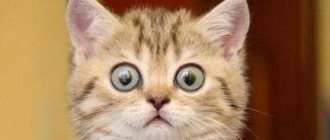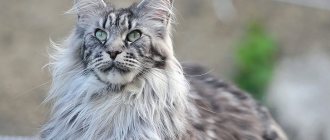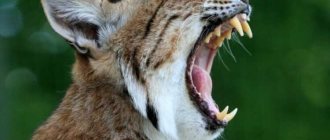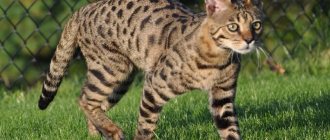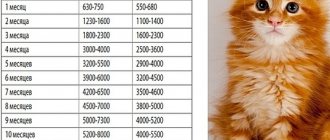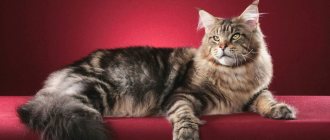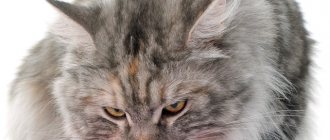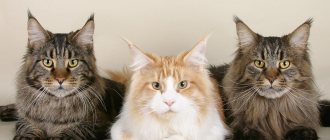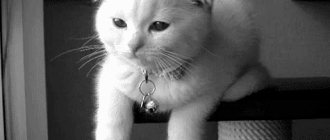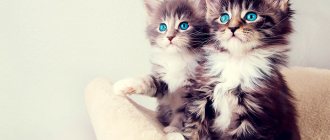The Maine Coon is one of the largest domestic cats, second only to the huge Savannah. Moreover, representatives of this breed are perfect for keeping even in small apartments.
Tassels on the ears, a muzzle with a “box” characteristic only of Maine Coons, powerful paws and impressive size give them some resemblance to a lynx. The brutal appearance sometimes gives a deceptive impression: people who are not too familiar with this beautiful breed mistakenly believe that such cats are independent and have a stern disposition. In fact, according to reviews from breeders and owners, everything is exactly the opposite - these gentle animals are completely alien to aggression, they are deeply attached to humans and, in most cases, are gentle and reverent towards children.
If you have long dreamed of having a representative of the feline family live in your home, but can’t make a choice, we suggest you think about this breed. Read all about what a Maine Coon looks like, what you should pay attention to when buying a kitten, and how to properly care for noble giants .
History of the breed
There are several legends surrounding the origin of Maine Coons, some of which are more comical than plausible.
So there are originals who confidently claim that the breed came from crossing a domestic cat with a raccoon, or even with a lynx. In their opinion, the similarity with the first ones is indicated by the presence of a long tail and stripes on the skin, and from their wild cat counterparts they allegedly inherited the famous tassels on the ears and impressive dimensions. It goes without saying that versions of interspecific crossing of different animals do not and cannot have anything to do with reality, since this is impossible from a biological point of view.
Another beautiful legend says that these cats were inhabitants of the mysterious Atlantis, and after the mythical continent sank, several individuals who managed to survive ended up in America, and some in Russia, becoming the ancestors of Siberian cats.
It is also rumored that the ancestors of Maine Coons were favorites of the notorious wife of Louis XIV, Marie Antoinette , who, knowing about the upcoming bloody massacre, planned to escape to America by ship. Alas, fate decreed otherwise, and the queen was executed, but her pets managed to cross the ocean on a ship carrying the unfortunate woman’s valuables, and quite successfully took root on the newly discovered continent.
A more plausible version is that modern Maine Coons descended from the Norwegian Forest, brought to America by the harsh Vikings long before its discovery by Columbus. These breeds do have some external similarities, but this theory has not received scientific confirmation.
In fact, most researchers and felinologists agree that the origin story of our heroes is much more prosaic. If you are distrustful of artificially bred breeds, then the Maine Coon is simply created for you, since it is the most aboriginal.
The distant ancestors of today's furry giants, so beloved around the world, are, in all likelihood, the indigenous inhabitants of the lands in the northeastern United States, namely Maine. The name of the breed consists of two words. The first part is a geographical name indicating the original habitat of the ancestors of modern Maine Coons, and the second is a derivative of “racoon”, which means “raccoon” in English. This combination was invented by a woman named Linda Choate , who is considered the ancestor and first breeder of Maine Coons to engage in their selection at a professional level. The owner of Tarbox Farm in New England turned her attention to the outstanding appearance and high intelligence of aboriginal cats. As a result of persistent breeding work, Linda managed to obtain the first representatives of the breed.
However, the favorites of the first settlers still owe most of their qualities to natural selection. The first inhabitants of these places were not particularly remarkable in size and generally resembled ordinary Europeans. However, the harsh cold climate, as well as crossing with representatives of long-haired breeds, contributed to the fact that each new generation of kittens acquired thicker and longer hair, which protected them from the cold, piercing winds and snow. To survive in extreme conditions, hunt large rodents and fight with their own kind for territory and food, animals required remarkable physical strength, endurance and outstanding mental abilities. As a result, nature rewarded the Maine Coon's great-grandfathers with a strong long body, powerful high paws, a developed chest, a massive head, a warm coat and a high level of intelligence. All these qualities made aboriginal cats the main assistants of local farmers. People quickly appreciated the excellent hunting qualities and unpretentiousness of giants.
The first Maine Coon to take part in exhibitions was a cat with the complex nickname Captain-Jenks-of-the-Sea-Cavalry. A significant event happened in 1861, and the public immediately liked the outstanding external characteristics of the spectacular cat.
However, later the attention of cat lovers switched to other furry owners of exotic appearance - Persians. Maine Coons were undeservedly forgotten, but, fortunately, enthusiasts managed to preserve and improve this unique breed, which was again remembered in its homeland after the end of World War II. In 1953, the official Maine Coon Breeders Club was created and registered, and in 1968 these amazing cats acquired their own Maine Coon Breeders and Fanciers Association. Europeans were less fortunate - they learned about the Maine raccoon cat only 20 years later.
Over the past few decades, these intelligent and noble creatures have won the love of “cat lovers” around the world, and now this breed is deservedly one of the most popular in the world.
pixabay.com/
The breed today
Marble tabby color
At first, only the color “black marble” was recognized. But later the standards became more and more lenient. Today all color variations are recognized. The breed experienced a surge of curiosity and recognition, then interest in big cats faded. The second round of popularity began in the mid-twentieth century. Today the breed is among the top five.
Maine Coons appeared in Russia in the early nineties. Over the years, many nurseries have appeared, releasing thousands of kittens into the world. We can say with confidence that cats with a unique history are not going to give up their position.
Interest in unusual cats is growing - who wouldn’t want to own a large predator shrouded in a mysterious origin story?
What does a real Maine Coon look like?
Perhaps everyone who has even a vague idea of felinology has heard that these are one of the largest domestic cats, but not everyone knows what a true Maine Coon looks like. We'll figure out.
So the Maine Coon is a cat that boasts above average size. The length of the body from the nose to the tip of the tail can reach 120 cm, and the height at the withers is 42 cm.
The question of how much a Maine Coon weighs often causes heated debate. On the Internet you can find reviews from owners who talk about giants weighing almost 30 kg, but in reality, of course, no one has seen such miracles.
The weight of an adult cat of normal build, not suffering from obesity, varies from 7 to 12 kg. Due to their physiological characteristics, cats are more miniature, but still significantly heavier than representatives of other breeds. The mustachioed “lady”, as a rule, weighs from 4 to 8 kg. It is not surprising that the dimensions of these animals in the photo look impressive even in comparison with an adult, not to mention a child.
The given standards are average, and among Maine Coons there are sometimes real record-breaking giants. A handsome man named Omar from Melbourne, Australia, was even included in the Guinness Book of Records for his impressive size. This hero weighs like a medium-sized dog - as much as 14 kg, and the length of his body is 120 cm. Omar's owners say that their pet was a completely ordinary kitten, but by the time he was a year old he had grown to 10 kg. Considering that Maine Coons grow up to three years old, even at such a young age it was clear that the owners got an outstanding specimen.
Stewie the cat, a champion in length, lived in the breed's homeland in Reno, Nevada. The length of his body was a little more than 130 cm. Unfortunately, he lived only eight years, but his death had nothing to do with his size - the animal suffered from cancer.
Our country also has its own giant. His name is Garfield, and he lives in Moscow. The Muscovite's weight is 13 kg and length is 117 cm.
But let's return from exceptions to norms and talk about what a typical representative of the breed looks like. Maine Coons have a long body, shaped like a rectangle, with well-developed muscles and a wide chest.
The paws are high, powerful, round. Tufts of fur may grow between the pads of the toes, a reminder of survival in the snow and harsh climate of North America.
The neck is of medium length and covered with thick hair. Especially among breeders, the presence of a rich collar, similar to a lion's mane, is appreciated, although not required. On the back and sides the coat is longer and coarser than on the belly and “pants”. It has water-repellent properties and it is not so easy to wet the thick undercoat, which creates the effect of a thermos.
The head has a somewhat elongated shape, which is also a consequence of the evolution of the breed. Thanks to the elongated snout, excellent rat catchers easily caught prey even from hard-to-reach burrows. In males it is much larger. The muzzle should be full, well defined and box-shaped. Its structure resembles that of a tiger or lion. The “strong-willed” chin gives the representatives of the breed a characteristic brutal appearance.
The eyes are wide-set, slightly slanted, very expressive. The color of the iris varies from yellow to green. Blue or multi-colored eyes are only acceptable for white coats.
Large ears with dense cartilage, wide at the base and ending in tassels are another distinctive feature of the breed.
The breeders are especially proud of their long fluffy tail, which can reach up to 36 cm and is equal to the length of the body. Its fur is flowing, thick and dense. In the wild, the tail did an excellent job of protecting against cold and wind - animals wrapped it around their body and thus warmed up faster. In domestic cats, there is no need for an additional source of heat, but this part of the body is involved in the process of coordinating movements.
The listed characteristics help to distinguish a purebred Maine Coon from a mestizo and cats of similar breeds, for example, Siberian.
Coons are distinguished by a wide variety of colors. The classic ones, on which the others are based, are black (black marble), red (for the common man - red), blue (in other words - gray) and cream. Pure color without a pattern is rare and is called “solid”.
If you see the term “tabby” in the description of a kitten, this means that the color has stripes. This coloring is also called marble for its similarity with the pattern inherent in this material. Wide spiral stripes on the sides look very elegant. If we are talking about the so-called ticked tabby, then in this case the stripes are visible only on the paws, chest and/or muzzle, and not throughout the body.
In smoky representatives, the tips of the hairs are painted black or gray, which looks very impressive, especially in movement, when the animal’s skin literally shimmers.
If you love the tortoiseshell color, characterized by a combination of multi-colored spots, then you need to keep in mind that it is characteristic only of female animals, while cats are not characterized by the presence of more than two colors. By the way, there is a belief that such colorful cats bring happiness, luck and prosperity to their owners’ homes.
pixabay.com/
Appearance description
The Maine Coon looks like a very large cat. But only some representatives of the breed reach great weight. For the most part, this impression is created due to the pet’s long and voluminous fur. The maximum weight of a female individual rarely reaches seven kg, and that of a male - nine. Although this breed is still considered large.
Maine Coon cats can reach a height of 0.4 meters, and a length (taking into account the length of their rather large tail) - 1.2 meters.
Maine Coons develop very slowly. This is the only breed in which maximum weight and body length are formed only at four years of age. From this period they are considered to have reached sexual maturity.
Distinctive features are not only large dimensions, but also cute tufts on the ears, powerful clawed paws with fur growing between the toes, and a luxurious fluffy tail.
Let's look at the standards of this breed:
- the head is quite large, longer than wide, the cheekbones are located relatively high;
- the muzzle is blunt, proportionally located on the head; in profile, such cats do not have an elongated narrow muzzle;
- the ears are quite large, gradually narrowing towards the top, covered with hair, ending in small tassels, located high, with a distance between them approximately equal to the width of the lower part of one ear;
- oval-shaped eyes, the iris can be any color, including blue (in cats that are white or have white spots);
- the Maine Coon's body is distinguished by proportionality, pronounced muscles, strong bones, a wide chest, limbs proportional to size;
- the limbs are straight, the paws are wide, with hair between the toes (there are five toes on the front legs, and four on the hind legs);
- the tail is long (up to 35-37 cm), wide, covered with long hair, straight, wide at the base, tapering towards the tip;
- thick, dense wool, silky to the touch, lengthens on the stomach, forming “pants”, the hair is shorter on the shoulders and chest, and a “collar” on the neck.
If the Maine Coon's coat is short or does not lengthen on the belly and hind legs, this is considered a fault in the breed.
Maine Coon colors are numerous and varied. These can be either solid colors of any color or mixed colors - bicolors, tabbies, torties.
Despite the fact that the natural species had only two shades of wool - black and red, as a result of numerous selections and mutations, the color range became much wider. Nowadays there are Mien Coons of cream, graphite, gray, blue, red, and white colors.
At shows, lavender, Himalayan and chocolate colors are a deviation from the standard and cause for disqualification.
Who are polydacts?
In some litters, polydactic kittens are sometimes born. They differ from their classic relatives by the presence of an additional finger, which can be on both the front and hind limbs. It should be especially noted that breeders have nothing to do with this phenomenon. The appearance of the sixth toe, like the entire breed as a whole, is a consequence of natural origin. It is believed that this paw structure allowed the distant ancestors of the coons to move more easily through deep, loose snow and hunt large rodents. Connoisseurs of the breed say that up to half of all cats - the ancestors of modern Maine Coons - were polydactics.
For modern cats, of course, these functions are not relevant, but the sixth toe makes the paw visually wider and more massive, which attracts some potential owners who are specifically looking for kittens with such an unusual “defect,” especially since there is an opinion that such pets are their their appearance brings happiness to the house. This superstition has its roots in the distant past, when sailors setting off on long and dangerous voyages believed that shipwrecks avoided those ships on which six-toed cats sailed with people.
Polydactyly does not affect the well-being or health of animals, but those who dream of an exhibition career must take into account the fact that not all felinological organizations recognize the owners of this mutation and it will be impossible to obtain a champion title with such a cat.
Interesting fact! In 1935, a captain gave Ernest Hemingway an unusual six-toed Maine Coon kitten. The snow-white baby was named Snowball, and he became the favorite of the famous writer. Subsequently, several cats always lived in the house of the Nobel Prize winner in literature on the island of Key West in Florida. The tradition is still alive today. About 50 tailed descendants of Snowball live in the Ernest Hemingway House-Museum, and tourists from all over the world come to meet them. It is curious that the writer often gave his four-legged friends nicknames in honor of celebrities. This tradition exists to this day, which is why Audrey Hepburn, Sophia Loren, Charlie Chaplin and Pablo Picasso “live” on the island of Key West.
The pets are allowed to roam freely in all rooms and the garden, and three lucky ones are even allowed to sleep on Hemingway's favorite bed. There is also a cemetery for animals on the territory, where the previous inhabitants who have passed on are buried.
pixabay.com/
Pros and cons of the breed
Features of Maine Coons are activity and activity, which is how they differ from other breeds. And also a serious, sometimes stern look, which absolutely does not correspond with a good character.
The breed still has many advantages:
- Maine Coon is first and foremost a companion;
- high level of intelligence, so it’s interesting to communicate with a cat;
- easy to learn;
- ability to get along with other pets;
- soft, non-conflict character;
- intelligence;
- devotion to the owner;
- nobility.
Disadvantages include excessive vigilance. A cat instantly reacts, for example, to a sharp unexpected sound or movement and can climb into a shelter somewhere very high.
Maine Coon character
Despite their impressive, almost “lynx-like” size and the stern expression on their brutal faces, which give these cats a resemblance to their wild relatives, Maine Coons are one of the most benevolent creatures in the world. Aggression and vindictiveness are absolutely not inherent in these good-natured giants. A Maine Coon will never allow himself to pee in your slippers or ruin your bed. Representatives of this breed are intelligent from birth. Torn furniture and wallpaper or problems with the toilet are not about them.
The Maine Coon's character and behavior are often compared to those of a dog. These cats treat all family members equally favorably, but they will choose one person as the leader of the “pack”, whom they will follow closely, without annoying or bothering with excessive attention. Wherever you are, the cat will be nearby. It must be kept in mind that these animals do not tolerate loneliness and separation from their owners well, so leaving them alone for a long time is not a good idea.
At the same time, Maine Coons are full of self-esteem and have difficulty enduring “personal violence” when they are squeezed or grabbed against their will. The animal will endure violent manifestations of love until the last moment and, most likely, will not scratch or bite, but will certainly try to break free and leave. And most coons are not at all enthusiastic about sitting on laps (which is rather an advantage, given the considerable size of these cats), but they are always ready to comfortably sit next to their beloved owner and purr loudly.
Coons treat strangers neutrally - without fear, with a degree of curiosity, but also without ingratiation. These cats always evoke the sincere delight of others and the desire to communicate with them closer, but they will never hang around your feet and fawn on your guests, no matter how much they might want it. If a person comes to the house often, then over time the animal will get used to it and will take his visits for granted.
In various descriptions of the breed, you can often find the statement that representatives of this breed are silent, and instead of the usual cat meow, they make peculiar sounds similar to purring. Judging by the reviews of the owners, this is not always the case, and it is possible that you, like the author of this article, will come across a very talkative specimen.
Maine Coons have a relatively calm temperament and are not prone to destruction. But young animals, of course, love to frolic and run around. Future owners need to understand that due to its impressive dimensions, outdoor games often unwittingly end in destruction, so it is better to remove fragile things and flower pots in advance.
Coons are very smart, inquisitive, easily adapt to the lifestyle of their owners and get along well with children and other animals. With patience and persistence, they can be taught some commands. The main thing is to do everything in the form of a game and in such a way that it is interesting, first of all, to your pet.
pixabay.com/
Tips for choosing a kitten
First of all, you should find out as much information as possible about nurseries and breed standards. This is especially important for those who are going to buy a show-class kitten and participate in exhibitions with it. All information can be found on TICA, WCF, CFA felinological systems.
Of course, it is important to decide on the gender and class of the animal you are purchasing, and also decide which branch you will choose. There are two of them: American and European. The first is distinguished by thick hair, wide and obliquely set eyes and larger sizes than the second. Europeans are relatively miniature, their fur is not so thick and long, but at the same time the “lynx tassels” are more pronounced.
After 12-15 weeks, you can purchase a kitten and take it to your home. If you purchase an animal from a good nursery, they will definitely tell you about each kitten and litter. The animal will be vaccinated according to age, branded, and all pets from the litter will be toilet trained and scratching posts.
If you see that the kitten is inactive, lies down all the time, and looks lethargic, then this is a clear sign of an unhealthy animal.
Ask the breeder to introduce you to one of his parents. By the behavior of the mother or father, you can easily determine the temperament of the future pet. Also, an experienced breeder will definitely give you food and filler for the first time, which the kitten has been accustomed to since birth. It is possible that your favorite toy will go with you, which will help the animal adapt more easily to new conditions. It is recommended to purchase Maine Coon kittens from nurseries so that you do not later discover any defects in your pet or raise a completely different breed instead of a Maine cat.
How to raise a truly big cat and what determines the size of a Maine Coon
Perhaps everyone who chooses a representative of this breed as a pet secretly or openly dreams that the kitten will grow into a huge cat weighing at least 10 kilograms. It’s no secret that Maine Coons are often purchased precisely because of their outstanding dimensions.
It is impossible to say for sure in advance whether the touching baby will grow into a giant, but nevertheless there are still a number of factors that can play a decisive role in the animal’s appearance. These include:
- genetics. Large parents are more likely to produce similar offspring. Therefore, before buying a kitten, or even better at the stage of planning the mating, it is advisable to get to know the baby’s mother and father. Moreover, look at both of them live, and not in photographs, from which it is difficult to judge the exterior, especially if the person is not a professional and is familiar with the breed from descriptions on the Internet;
- gender Please note that cats are always larger. Cats are distinguished by a more elegant and graceful physique;
- good breeder. You need to be extremely careful when choosing a nursery from which to adopt a new family member, since the appearance and, most importantly, the health of the future pet depends on how responsibly the owner of the parents treats his business. A competent breeder is not just an amateur who bought animals of different sexes and began to cross them to produce offspring for sale, but a professional and enthusiast of his business, conducting serious breeding work. With the right approach, you will definitely be invited to visit to meet and communicate with the animals, as well as look at the conditions of their detention;
Important! Maine Coons are late maturing cats. Kittens of this breed should not be separated from their mother early. A normal breeder will never give up a baby before 3-3.5 months. So you’ll have to wait a little, but then you’ll get an absolutely adequate, well-socialized animal trained in all the wisdom of a cat.
- proper care and feeding. And already at the stage of pregnancy of the cat. Be sure to ask the breeder what the expectant mother ate and whether she was given any medications. A conscientious breeder will not hide this information from the potential owner, since he is more interested than anyone in ensuring that the kitten ends up in good, caring hands.
pixabay.com/
How to choose a kitten
A kitten is usually reserved at the nursery at the age of 1-1.5. The right of “first choice” is agreed upon even before the birth of the offspring. Babies are taken away at 3-4 months, after they have been vaccinated and quarantined.
Maine Coon kittens are not chosen based on photos. You should definitely visit the nursery and observe the litter. You should not choose the smallest and most defenseless. For the future owner, this may result in constant visits to the hospital. A Maine Coon kitten should be healthy, moderately well-fed, and playful. There should not be a full belly at 3 months. This rather speaks not of health, but of digestive problems. The gait is confident and there are no loose legs - when the hind legs are X-shaped and the front ones are widely spaced.
Content
The Maine Coon is not an ordinary breed. Due to their physiological characteristics, they require somewhat higher maintenance costs than cats of more modest sizes.
When planning to get a little coon, many people wonder how much kittens cost. Prices for purebred animals from good nurseries start from 20 thousand rubles (if you are very lucky) and can reach 100 thousand and above - depending on the title of the parents and the objectives pursued by the buyer. Naturally, a kitten of the so-called pet class, which is destined to become just a pet, will cost several times less than a candidate for a successful exhibition career, although both of them can ultimately grow into luxurious giants with outstanding breed characteristics.
However, it is not enough just to buy a kitten from wonderful parents, even for a lot of money. The main thing is to provide him with decent care and maintenance.
Representatives of this breed feel great both in a city apartment and in a country house. Of course, the second option is ideal due to more free space and the ability to regularly breathe fresh air. If you live in your own home, your number one task is to provide a safe walk for your pet. Despite their impressive size and harsh appearance, these cats are completely unsuited to life on the street and will not be able to protect themselves in case of danger. They are not very agile, and they don’t know how to fight at all. The times when they protected North American farms from rodents are long gone, and the modern Maine Coon is a friendly companion, not a cunning and resourceful hunter. The best thing you can do for your four-legged mustachioed friend is to build a spacious enclosure, closed on all sides, with access directly from the house. Place logs and branches of various configurations and sizes inside, and your pet’s gratitude will know no bounds. Such a walking area will provide your pet with the necessary amount of fresh air and sun, and will also satisfy the need for games and movement.
If you are not the happy owner of your own house in the village, then it is quite possible to provide a coon with decent living conditions in a city apartment, but with reservations regarding the dimensions of the new home. Maine Coons have a calm and balanced character, but the kittens are not averse to frolicking, and if you take into account the fact that they remain kittens for up to three years, and their weight by the year can reach 10 kg, then it becomes clear that everything is easily breakable and represents It is better to remove artistic value away.
Also, do not forget to protect your inquisitive pet from falling - never open windows wide if there is a cat in the room! Or place special grilles (not meshes!) in the openings.
To provide the coon with sufficient physical activity, the owner needs to think about purchasing a special play complex for cats. It should be high enough, but stable, with wide, spacious areas, hammocks or houses where the animal can relax and retire. At the same time, such a complex will act as a scratching post, keeping the upholstery of your furniture safe and sound. Such devices can be bought at a pet store or made to order. Many manufacturers have special lines for giant cats. Give preference to these, although they are somewhat more expensive. But your cat is also unusual, isn’t it?
If we talk about nicknames that are suitable for Maine Coons, then such a majestic animal needs an appropriate name. Among boys, Duke, Count, Viscount, Martin, Mars, Admiral, Patrick, Sean, Askold are often found. The girls are called Duchess, Adele, Olivia, Quinn, Stella, Ursa, Martha.
pixabay.com/
Feeding
The Maine Coon does not require a particularly special diet, but it is important to consider that it is a large and active animal. Nutrition should be complete and varied, including all the vitamins and microelements necessary for the animal. Experts do not give clear recommendations regarding whether to give dry or canned food to your pet.
As a rule, it is advised to feed mostly dry food, and offer canned food several times a week. All quality cat food manufacturers have special lines designed specifically to meet the needs of large cats. So they are suitable for Maine Coon.
In any case, homemade food is not suitable for Maine Coons, although some owners prefer to feed their pets this way.
You can give your cat natural food, but then you need to carefully select his diet. About three quarters should be various types of meat, and only a quarter should be milk and dairy products, seafood, eggs, and vegetables. With such a diet, it is important to give your pet vitamin and mineral supplements to its food.
Food specially produced for cats contains the substances necessary for the animal; high-quality dry food is an excellent prevention of tartar. Breeders recommend choosing dry food and canned food, the main component of which is some kind of meat.
For Maine Coons, food based on any grain crops is contraindicated, since genetically these cats are not predisposed to digest them. This is due to the fact that in natural conditions their ancestors never ate grain, and such feeding can cause various diseases in the pet, in particular diabetes or obesity.
It is not recommended to mix natural food and specially produced food, and you should not constantly change them or use several brands at once. It is better to accustom your pet to the diet of one manufacturer from childhood and not to use others unless absolutely necessary.
Dishes intended for the animal are important. It is best to purchase metal or glass bowls. This can be dishes made from any natural material, but not plastic.
Plastic feeders can cause allergies and other unpleasant ailments.
Hygiene and health
Maine Coons, due to their natural origin, are quite unpretentious, however, their long hair with a thick undercoat requires appropriate care, otherwise tangles cannot be avoided, which cause discomfort to the animal and look untidy. To prevent their formation, brush your cat twice a week, paying special attention to the armpits, belly and panties. It is advisable to accustom the kitten to the procedure from childhood so that problems do not arise in adulthood.
You should wash your pet as soon as it gets dirty. As a rule, problems arise with this because coons love water, although there are exceptions here.
Keep an eye on your pet's eyes and ears - they should be clean and free of discharge.
These smart giants have no problems with toilet training. Kittens learn basic skills from their parents, and they come to their new home with the correct ideas about “dos” and “don’ts.” The only thing the owner has to worry about is purchasing the right tray. It should be deep and roomy. The ideal option is a toilet house. A special filter is built into its “roof” that absorbs foreign odors. There are no special requirements regarding the choice of litter - everyone chooses the option that seems more convenient and suits a particular cat.
In general, Maine Coons are characterized by fairly good health, but they have their own special diseases. In particular, cats and cats of this breed are susceptible to hypertrophic cardiomyopathy. It mainly affects older animals, but the pathology also occurs at a young age. In addition, due to their large size and significant weight, representatives of the breed experience problems with the musculoskeletal system, so it is strictly forbidden to overfeed your pet and allow the development of obesity.
The average lifespan of a coon is 12–14 years, but some individuals lived up to 18.
Mating and pregnancy
Maine Coons, unlike other breeds, have a longer gestation period - pregnancy lasts an average of 68 days.
The selection of a pair is no different from other breeds. If a Maine Coon cat is approved for breeding, then they sign up for mating through the club.
You cannot breed a cat under one year of age. It is better to be older so that the body is fully formed. Females whose estrus is intense with a frequency of 2-3 weeks are bred at the age of 12-18 months. Otherwise, high levels of hormones can cause diseases of the reproductive system.
Maine Coons are strong and resilient. They bear offspring without any problems and give birth themselves. The breed is classified as having multiple births. On average there are 4-6 kittens in a litter. However, this is an individual process, so there are 1, 7 or 9 kittens in a litter.
One of the features of Maine Coons is that the male also takes care of his offspring, like a cat, protecting the cubs.
Interbreed matings are allowed. Maine Coon can be bred with the following breeds: Siberian, Turkish Angora, Norwegian Forest.
Character, temperament, behavioral characteristics
Maine Coons are wonderful companions. They have a balanced psyche, are phlegmatic in character, and sometimes even serious. The cat will happily pay attention to you if you do not cross the boundaries of her personal space. Therefore, you should carefully study their worldview by observing the cat’s reactions to various stimuli. The coon is unlikely to purr affectionately on your lap, but will happily lie down to doze at your feet, or somewhere nearby. Just like many other wayward cats, they often choose a single owner and obey only him. Having fallen in love with one person, they are ready to accompany him in all his affairs, even if these affairs are too personal.
There is also a feature that comes as a real surprise to many Maine Coon owners. This is a thin and ringing voice, which certainly does not fit with their menacing appearance. These cats talk quite rarely, more often they can rustle, as if purring. These sounds are difficult to interpret in any way, since they have their own unique timbre. But there are also quite talkative individuals who, during the period of heat, begin to drive their owners crazy - take this calmly, an older cat will be quieter than a teenage kitten.
Of course, Maine Coons can be naughty. And if you have offended the cat in some way, then his revenge can take on the proportions of a catastrophe. They know how to stomp like elephants, turn flowers out of vases, break cutlery, and not only that. Sometimes cats can harbor a universal grudge against you, but, fortunately, this does not last long. By the way, periods of revenge and pogrom will also not last long: Maine Coons are scops owls, and sleep is much more important to them than any pranks. Some representatives of this breed love to swim with passion. Owners often share stories of how their pets enjoy splashing around in the water, playing with it, or drinking water by licking it off their paws.
Cats value their personal space much more than males. They won't be able to be cuddled or crushed, but they will happily allow themselves to be petted. Of course, if they are in the right mood. If a cat wants affection, it will come to its owner. But it’s better not to touch a sleeping animal, no matter how much you want to. Sudden interruptions to your nap can result in a puddle in your shoes or yet another broken flower. In the first years of life, pets are most active, and after five years they calm down, become passive and are more lazy.
They extremely quickly remember the habits of their owners and also adapt to them. Do you work on a computer? The cat will contemplate all your activities. When you come home from work, are you looking for slippers? Don't be surprised if the kun brings them to you in his teeth. Well, if you like to cook, then he can become your personal taster. They try not to notice strangers and guests in the house. Everything foreign and unusual is alien to them. They really love constancy and stability.
Males, like cats, take care of their offspring, care for kittens and raise them.
Despite the lack of need for apartment cats to obtain food, their hunting instincts can make themselves felt from time to time. Therefore, it is very important to accustom them to a routine from childhood so that the cat understands that discipline is important. Maine Coons are well trained: they have an excellent memory, thanks to which they remember commands remarkably well. Such cats will master the litter box in a matter of days, and the same can be said about the scratching post. When choosing activities for your cat, consider its origin and instincts. The best toys for such a pet would be toy mice, laser pointers or cat balls.
Features of care
The most suitable place of residence for such a cat would be a dacha or a country house, where the animal will have enough freedom to walk and hunt. Although experts unanimously confirm that it is still possible to adapt a freedom-loving coon to a small apartment. If your situation looks like this, then you can accustom your cat to a harness and compensate for the lack of physical activity with short walks. If the owners do not have enough time to exercise and play with the cat, it is worth making sure that he has the opportunity to entertain himself.
Grooming the coat does not cause much trouble. To avoid tangles, it is enough to comb the coat several times a week with a special comb. It is important to pay special attention to the undercoat on the sides and tummy, where the fur mats the most. You should brush your cat as carefully as possible: some areas of the body, including the inner thigh and neck, are very sensitive in cats. As for bath procedures, they should be carried out no more often than once a month. There are usually no difficulties with taking a bath, since adult individuals behave quite calmly in the water, and some even enjoy it.
The inner surface of the ear is another place that requires close attention. It is important to keep your cat’s ears clean and, if necessary, wipe them with a piece of gauze or a cotton pad. If the cat shakes its ears or scratches them too intensely with its paw, this is a sign of discomfort.
Maine Coons' claws tend to grow rapidly. They should be trimmed about once a week, using a special nail clipper.
When buying a kitten, you should understand that adult Maine Coons are significantly larger in size than their standard counterparts. This means that a standard tray for “dirty matters” is definitely not suitable for such a cat. It is best to buy a spacious tray right away to avoid unnecessary costs.
As for feeding, a high-protein diet is important for Maine Coons. You don't need to follow any special diets. Therefore, you can safely get by with store-bought canned food or high-quality dry food. The most suitable natural treats for cats are beef, chicken, and lean fish. Taboos should immediately be placed on fatty meats, sweets and potatoes. If you still choose commercial food, it is better to buy premium food and higher, since they are made from natural meat and do not contain cheap chemical additives.
The food bowl should also be larger than for a regular cat. Plastic is not the best material for water bottles, as it can cause allergies in Maine Coons. The most acceptable bowl options are tempered glass, ceramics or stainless steel. It is advisable to feed an adult at the same time twice a day. Changing water - also twice a day.
Maine Coon diseases
Among the many representatives of the cat family, "Maine raccoons" are considered real tough ones. This is true, because coons have excellent immunity and are rarely exposed to diseases. They live for about 12 years, but there have been cases of some representatives of the breed living up to 16 years. The weakest points in Maine Coons are the kidneys and heart.
Hypertrophic cardiomyopathy
usually occurs in older cats over 9 years old. This is a hereditary disease that can lead to pulmonary edema or paralysis of the limbs. Unfortunately, such diseases in cats are considered incurable. Therefore, before any surgical interventions, it is worth checking the heart with an ultrasound.
Hip dysplasia
. It appears mainly in old age. The joint gradually begins to wear out, as a result of which the animal’s gait acquires a characteristic lameness. The causes of dysplasia can include both heredity and too much weight.
Polycystic kidney disease
. It is one of the most commonly inherited diseases in cats. Manifested by increased thirst, decreased appetite, lethargy and apathy.
Spinal muscular atrophy
. Appears before the age of one year. The main signs are instability of the back of the body when walking, and difficulty jumping onto heights.
If you don't care for your pet well, abscesses, bald spots, and dandruff can occur. Typically, this can be caused by frequent bathing, allergic reactions to shampoo, or poor grooming.
